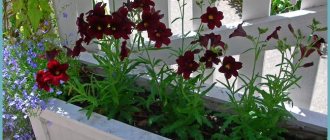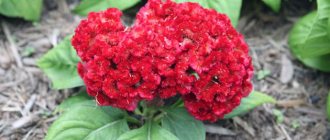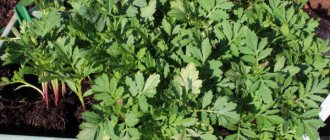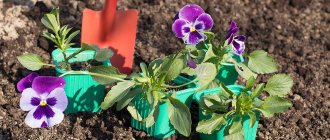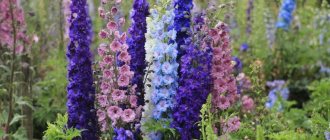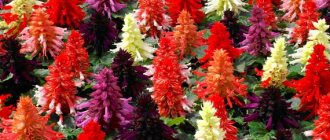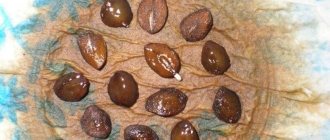Many people know this popular, short-lived perennial from the plantain family. Modern varieties are long-flowering plants with double petals, different colors and shapes, characterized by a pleasant smell. The flower is often grown in rural gardens and summer flower beds. When to plant snapdragons, growing from seeds, care after planting and other aspects of plant care are described in this article.
Description and characteristics of the plant
The genus Antirrhinum Antirrhinum includes more than 20 species. Snapdragon (Antirrhinum majus) is the type species of the genus Antirrhinum. It is a herbaceous plant with light green lanceolate leaves. The shoots are erect, slightly woody at the base, the leaves are lanceolate and rounded. Under natural conditions it is a perennial plant, but in our climate it is grown as an annual. Pollinated only by bumblebees and bees.
The plant bushes heavily. Height depends on the variety:
- dwarf varieties grow up to 20-25 cm;
- the large antirrhinum reaches a height of 90 cm.
Flowers with a double lip and a baggy swelling at the base, reach a length of 2.5-5 cm, are simple and double. The flowers are collected in racemose, cluster inflorescences located at the tops of the shoots. The petals have a funny, characteristic shape - when pressed, they open wide, reminiscent of the mouth of an animal. Thanks to this feature, people often call this flower “dogs,” which children love to play with. Most varieties smell pleasant.
Dog flowers are suitable for gardens where children play. They are not poisonous.
The color of the flowers is also attractive and varied - all colors are found except blue. Particularly good are varieties with snow-white, lemon, apricot, red or cherry flowers, often with a velvety coating. There are two- and multi-colored flowers. Flowering lasts from July until the first frost.
Interesting facts: Antirrhinum is native to Southern Europe and North Africa. In the United States, this plant is one of the most popular cut flowers grown in greenhouses.
Variety Madame Butterfly
Snapdragon – description, photo
What does a snapdragon look like? The antirrhinum flower is distinguished by green, straight, finely grooved, large stems, the height of which can be from 15 to 100 cm. The plant has opposite lower leaves and oval or lanceolate elongated upper leaves. By the beginning of summer, racemose inflorescences with numerous large, two-lipped flowers form on the stem. They have an irregular shape and can be simple or terry. The color of the flowers can be pink, red, dark brown, orange, yellow, white. There are varieties with flowers painted in two or three colors at once. Snapdragon blooms from the beginning of summer until the onset of autumn frosts.
In nature, the snapdragon flower is a perennial, however, in regions with cold winters the plant is grown as an annual. Under favorable conditions and good care, antirrhinum can be grown in the garden as a perennial plant.
Requirements for soil and planting site
Planting and care after planting require compliance with certain rules.
Soil: grows well in any variety, but fertile, humus, constantly moist, but not waterlogged soils are preferred. Well-drained sandy loam soil, preferably calcareous or with a neutral reaction, is better suited.
This plant requires rather a mineral substrate (excess peat should be avoided) and is sensitive to salinity. Moderate soil moisture should also be maintained.
Position: The position should be sunny or partially shaded.
Flower garden care
If the young seedlings of our pet are very tender, then the already grown seedlings after transplanting into the garden bed are completely undemanding to the conditions and require minimal care. It is usual: timely watering (only when the soil dries out), rare fertilizing, loosening the soil and removing weeds. Fertilizing is applied 10-15 days after planting in the garden bed, and then just before the buds open. They use, for example, azofoska or special flower fertilizers. In addition, tall varieties are sometimes tied to supports.
If you don’t want to get seeds, after the first shoots have flowered, they are removed, thereby prolonging flowering for a long time. It is necessary to cut out the entire arrow, including the lowest fading flower, otherwise new shoots may not form.
This flower gets sick in a flowerbed very rarely, only under unfavorable weather conditions or an unprecedented invasion of any infections. Therefore, flower growers almost never carry out even preventive spraying, and in the event of any trouble, they look for treatment recommendations in specialized literature.
Reproduction, sowing seeds for seedlings
Snapdragons are planted in spring in May in open ground or earlier - in planting boxes. You can collect the seeds yourself.
Photo. Antirrhinum seeds. As the flowers fade, the inflorescences begin to dry out and the capsules open to release the mature seeds.
It's worth buying certified flower seeds every few years because purchased seeds tend to have better health. Seeds remain viable for 2-3 years. Germination rate is 55%, so to get 1000 plants you need to sow about 0.5 g of seeds.
Seeds can be sown in late February - March in pots and kept at home, in a warm room or greenhouse. Sowing soil for growing seedlings should consist of peat and sand mixed in a ratio of 2:1. A pH of 5.5-6.6 is recommended.
Seeds are sown in rows in boxes filled with steamed, well-drained soil. The seeds are not covered with soil, but lightly pressed into the soil. You can sprinkle them with a very thin layer of fine peat sand.
Advice. The seeds of the large antirrhinum are very small, so to make sowing easier, they should be mixed with fine sand and sown immediately.
When maintaining moderate soil moisture, temperatures in the range of 18-20 °C and slight shading, hybrids germinate within a week; other varieties germinate in 10-14 days.
After the emergence of seedlings, the boxes with plants should be transferred to light, well-ventilated greenhouses, reduce the temperature to 15 ° C and water them only after the first signs of wilting of the seedlings are noticed.
To keep the plants large and strong, seedlings should be planted, for example, in peat pots. Picking is carried out approximately 4 weeks after sowing or after the first true leaves appear. Seedlings are planted in boxes at intervals of 2 × 3 cm. The seedlings need to be slightly shaded so as not to burn the tender young shoots.
Photo. Seedlings after picking.
When the seedling reaches 10 cm (mid-April, early May), it can be transplanted to a permanent location. When planting in a permanent place, seedlings should be placed very shallowly, no deeper than they grew in the place of sowing, because excessive pressing often causes rotting of the root collar.
Planting pattern:
- low varieties are planted at a distance of 20 cm;
- high – every 35 cm.
Antirrinum planted in open ground in May will bloom only in early August. Flowering begins 10 weeks after sowing. The seedlings grow slowly.
In areas with a mild climate, the plant is sown independently and begins to bloom in the spring.
Photo. Seedlings grown from self-dispersed seeds
Snapdragon can also be easily propagated by rooting cuttings taken from apical and lateral shoots.
Planting seeds in open ground
The method is less popular than growing beautifully flowering snapdragon seedlings. Seeds are sown directly on a lawn or flowerbed if warm weather sets in in the region already in May, frosts are rare, spring is early, and the soil warms up quickly.
Suitable timing
The right time is early May. It is important that there are no night frosts. It is important to select high-quality, large seeds. Some gardeners advise keeping the planting material in a solution of potassium permanganate for disinfection (30 minutes) and then placing the seeds in a growth stimulator for 3 hours.
Choice of location and lighting
Snapdragon grows well in open areas, light shade is acceptable. When planting antirrinum under trees, in shaded areas, the flowers are small, the bushes do not stretch out as expected for a certain variety, and the decorative effect is reduced.
Optimal options: flat terrain, not in a lowland, not in a swampy area, away from trees with a dense crown. In the complete absence of shade, the plants bloom well; it is only important to ensure timely soil moisture. You must follow the landing rules.
Growing and care
Snapdragon is quite easy to grow, although it has certain requirements; growing seedlings yourself can be a little troublesome. The advantages include the fact that the plant tolerates autumn cold well and blooms until October.
Pruning, watering
To improve flowering, the ends of the shoots of young plants should be trimmed. Faded inflorescences must be trimmed regularly so that the antirrhinum begins to bloom again. But after pruning it will not produce seeds, and we will not be able to collect them next year.
Antirrinum requires watering throughout the flowering period. Water only when the substrate is dry and the plants show symptoms of wilting. When watering, avoid soaking the leaves.
Fertilizer
Before planting in the greenhouse, it is recommended to add approximately 1.5 kg of azophosphate and 0.5 kg of triple superphosphate per 1 m³ of prepared substrate. The optimal level of mineral elements for the growth and flowering of antirrinum, expressed in mg/l of substrate, is:
- N = 100-150,
- P = 100-200,
- K = 350-500.
Peat is added to the substrate in small quantities, as it constantly maintains high humidity around the roots, which is unfavorable for these plants.
At the beginning of summer, antirrinum should be fed 2-3 times with mineral or organo-mineral fertilizers, preferably 2-3 weeks before flowering. Annual plants can be fertilized throughout the growing season, even in August.
During the formation of flower buds, antirrhinum is fed with a 0.2% solution of mineral fertilizers with a predominance of potassium.
Fertilizing plants with nitrogen and too much salinity in the substrate is dangerous. When flower buds become visible, fertilizing should be stopped.
Wintering
In the southern regions, this perennial plant can survive the winter if dug in. This was discovered by accident when the antirrinum was buried for the winter along with roses growing nearby.
Wintering conditions:
- For wintering, the perennial variety must have woody shoots. It is enough that the main shoot and, possibly, side shoots are woody near the ground. Green shoots have no chance of surviving frosts in winter, even under a huge mound of earth.
- Height of the earth embankment. The mound must be large enough to cover the entire plant. Non-lignified shoots may protrude; in any case, they will freeze.
- If the plant is tall, you can tilt it, lay it on the ground and then build a mound.
- It is better to protect the plant from frost with regular soil. Before covering with soil, you can cover the plant with a piece of agrotextile. This is not done to keep the plant warmer, but to make it easier to remove soil in the spring.
- The period of shelter is like that of roses - at the turn of October - November.
- Removing cover - like roses - when forsythia blooms. Dead shoots should be cut off. The overwintered plant blooms very well in April.
The disadvantage of wintering is the “ruffled” shape, but this can be corrected by pruning.
The shoots of perennial antirrinum are the thickness of a pencil.
Snapdragon - care
Snapdragon is an unpretentious plant that does not require much attention during the season. The bushes will bloom magnificently and for a long time if you follow simple recommendations for caring for them:
- In dry and hot weather, plants require watering. This should be done early in the morning. It is not recommended to water snapdragons at night. If it rains, there is no need to water the flowers.
- After rain or watering, it is recommended to remove weeds and loosen the soil around the plantings approximately once a week. This procedure will prevent the formation of a crust on the soil, and air will flow to the roots of the plants.
- After about two weeks, when the seedlings take root and begin to grow, they are fed with universal fertilizers for flowering plants.
- During budding, it is recommended to feed the bushes with a solution prepared from a mixture of potassium sulfate, urea and superphosphate. To prepare it, take a tablespoon of each fertilizer. The mixture is diluted in 10 liters of water.
- Wilted flowers should be removed regularly so that new buds form faster.
- After flowering, fruits begin to form and ripen on the peduncle. If you do not need the seeds, then cut off the faded peduncle under the lowest flower. In this case, after some time, new arrows will appear on the bush and begin to grow, which will soon bloom.
- In regions with not very cold winters, where snapdragon is grown as a perennial plant, in the fall, with the onset of cold days, you need to cut off the plant's stem. The remainder of the stem should have a height of 5 to 8 cm. After this, the bushes are covered with dry leaves or peat mixed with sawdust.
You will be interested to know: Celosia: the secrets of growing from seeds, when and how to plant seedlings
Greenhouse care
The plants in the greenhouse need to be provided with the maximum amount of light, only the seedlings should be shaded. The air temperature should not exceed 15 °C; Frequent ventilation is also necessary.
In heated plastic tunnels, this plant can be grown as in a greenhouse, while in unheated rooms it is recommended to grow it mainly for collecting flowers in late spring (May-June) and early autumn (September-October). Summer is less favorable for growing this plant in a plastic tunnel due to the persistence of too high temperatures and high humidity. Spring cultivation under film can be a good precursor to autumn cultivation of chrysanthemums.
Temperature:
- At night, the plant should be kept at a temperature between 8-10 ° C;
- during the day – from 1 to 15 °C.
It is necessary to frequently ventilate the greenhouse and provide the plants with the maximum amount of light.
The plant responds favorably to long days, which accelerates the swelling of flower buds. Tall varieties require support to ensure growth.
Collecting seeds
After flowering, a seed capsule is formed, which includes a large number of seeds . The seeds are black, small in size, with a clearly visible shine. Visually they are similar to poppy plants.
The seed pod is very similar to a human skull
To collect seeds, choose strong plants with beautiful flowers . Inflorescences can be shortened by 1/3. In place of the flowers, a seed box is formed.
You should not wait for the seeds to ripen directly on the plant. It is necessary to cut off the inflorescence and send it indoors for ripening.
The fact that the seeds are ready will be indicated by a change in the color of the box, which will acquire a yellowish tint. After ripening, the seeds are shaken out into a paper bag. The seeds can be dried a little more, put in a plastic bag and put in the refrigerator for storage.
Seeds prepared according to all the rules retain 100% germination for 4-5 years.
Diseases and pests
Antirrinum does not have excessive requirements, but problems associated with infection by pathogenic microorganisms may arise. The plant can be attacked by diseases - rust, anthracnose.
In unfavorable agrotechnical conditions (too high temperature, nitrogen overload, poor ventilation in the greenhouse, high air and soil humidity, excessive density), plants are often affected by Phyllosticia or brown spot (pathogen - Phyllosticia antirrhini). Gray-brown spots quickly cover the leaves and shoots, the plants wither and die. The fungus is successfully combated with drugs - Ditan (0.2%), Captan (0.2%).
Plant diseases caused by pathogenic microorganisms - fungi of the genera Verticillium and Fusarium - may also appear. Their occurrence is prevented by decontaminating the greenhouse, sowing boxes and soil, and treating the seeds. These diseases are difficult to control, their spread can be limited with the help of drugs - Benlat (0.2%), Topsin M (0.2%), Funaben (0.2%).
Rust appears as chocolate brown spots on the leaves where the spores spread. The disease is caused by the pathogen Puccinia anfirrhini. Control the disease with fungicides. Symptoms are characteristic greenish-yellow spots on leaves and shoots, causing the death of leaves and then of entire plants.
The development of rust is promoted by:
- tight fit,
- undisinfected soil,
- high humidity.
After observing the first signs of rust, Cincotox (0.3%), Dithane M-45 (0.2%) and Saprol (0.1%) are alternated every 7-10 days.
Sometimes the plant is affected by powdery mildew (false or true), rot. At the seedling stage, rotting of the neck may be observed - black collar (can cause large losses in the early stages of plant development). At the same time, the neck of the stem darkens and the seedlings break.
Among the pests you should beware of aphids and spider mites. To combat these pests, it is recommended to use insecticides or acaricides at intervals of 10-14 days, for example, Pirimor (0.1%).
Floriculture: pleasure and benefits based on materials from the site Gardenia.ru / https://www.gardenia.ru
_____ 10/27/2005 _____________________________________________________(N 90)
Dear florist!
November is coming - the last month of autumn. It's time to prepare green pets for the winter, provide them with special conditions so that they remain healthy and have a good “rest” before the spring, a rapid period of growth. Galka Okhapkina writes in her article “Wintering of indoor plants” about how our pets can safely survive the winter, and how we can not deceive their “expectations.” Answers to the most pressing questions about winter maintenance of plants - how to ensure the correct watering regime, regulate the temperature of the content, and help the plant go into “hibernation” - are contained in this article. We meet again with the experienced cactus grower Svetlana Luneva, who continues to introduce us to her experience in grafting cacti. In the article “Grafting Cacti: How Do I Do It?” The grafting process is consistently outlined and is accompanied by illustrations that clearly demonstrate how even very tiny cacti can be vaccinated. Svetlana talks about a variety of scions and rootstocks, her experience of combining them, as well as how to graft cacti in an extreme situation, when the specimen you want to preserve is sick and needs to be saved.
Flower Parade: Snapdragon
section “Garden and Me” https://www.gardenia.ru/garden.htm
Snapdragon is undeservedly deprived of the attention of many gardeners - you won’t find it in every garden. It seems to me that this is due to the fact that not everyone is yet familiar with its undeniable advantages: unpretentiousness, bizarre shape and amazing variety of flower colors, bright, abundant and long flowering from June to October. Only the gardener who at least once planted and carefully nurtured this grateful plant got the opportunity to appreciate it fully; often ranks him among his “favorites”. For many years I have been growing snapdragons and cannot imagine my garden without it, traditionally decorated with its flowering bushes all season long.
Snapdragon, or Antirrinum (Antirrinum) is a perennial plant of the Norichaceae family native to the Mediterranean countries. In floriculture, only one species is used - antirrhinum major (A. majus), which is the source for modern varieties. Snapdragon has thin, but hard and durable shoots that become woody in the lower part. Antirrinum is capable of flowering and producing seeds already in the first year, so it is mainly grown as an annual plant. However, under favorable conditions, well-developed, with a powerful root system, fairly cold-resistant antirrinum bushes can overwinter not only in the southern regions, but also in the middle zone (I cover them with various tops in late autumn). Snapdragon forms a highly branched bush, densely covered with small leaves; its elegant spike-shaped inflorescences with numerous flowers are directed towards the sun. The light-loving snapdragon develops well and blooms profusely only in a sunny place, when it grows in fertile and light, well-drained, non-waterlogged soil. Antirrinum tolerates light shading, but with a lack of light it cannot express itself in all its glory.
Snapdragon does not tolerate air and soil drought well, therefore, in the absence of rain, in the heat it requires regular watering - otherwise the leaves droop and flowering stops; Some of the shoots may even dry out. However, when the drought ends, the heat subsides and life-giving moisture enters the soil - the antirrinum bushes are quickly restored, and their mass flowering resumes. To prevent diseases from appearing, it is advisable to water the snapdragon in the morning, at the root. Faded inflorescences reduce decorativeness, and ripening seeds reduce the intensity of further flowering of snapdragons, so inflorescences with green ovaries-boxes are removed in a timely manner. If the autumn is fertile, then snapdragon, after the summer heat and dry air, quickly “gains new momentum” and “opens a second wind”, delights with its numerous flowers until significant autumn frosts.
Breeders have created hundreds of varieties of snapdragons, differing in height, shape and color of flowers. Depending on the height of the plant, there are dwarf (15-20 cm), short (25-35 cm), medium-sized (40-50 cm), tall (60-80 cm) and gigantic (90-100 cm) varieties of antirrinum. Many people are familiar with the traditional shape of the snapdragon's two-lipped corolla, reminiscent of a small lion's face, for the resemblance to which the plant got its name. If you lightly press your fingers on both sides on the tubular base of the corolla, its “pharynx” will open slightly. Less familiar to flower growers is the open form of the flower (nemesioid, penstemonoid, bell-shaped) - its petals do not grow together into a lip; The double flowers (azale-shaped) are very beautiful. Looking at the snapdragon bushes with such unusual flowers, it’s not even immediately clear what kind of strange plants they are. Antirrinum flowers of different varieties have a wonderful variety of colors: white, yellow, orange, bronze-brown, salmon, pink, red, crimson, purple in different shades, even two-tone and striped. The color of the flowers can be light, dark, bright, or delicate pastel colors (they cannot be described in words - multi-colored with smooth shade transitions). Snapdragons can be grown year-round in a greenhouse; it is suitable for forcing for cutting in winter. Professional flower growers divide snapdragon varieties according to flowering periods into 4 groups: 1 - winter-blooming (short-day varieties and hybrids); 2 - blooming in early spring and late autumn; 3 - blooming in late spring and early autumn (long-day); 4 - blooming in summer (long-day).
Snapdragon inflorescences, which produce a first-class cut, are used for making bouquets and arranging flower arrangements; cut inflorescences are stored in a vase for a long time (about 1.5-2 weeks). The spectacular flowers of Antirrinum have a weak, unobtrusive aroma, which is important for a bouquet and for keeping the plant indoors. Dwarf antirrinums are grown as a potted crop; just one compact plant, covered with numerous flowers for a long time, gives the impression of a rich bouquet.
Legend says that not far from the ancient Greek city of Nemea, in the Nemean Forest there lived a huge and terrible lion. Every day the lion attacked people, killed and ate them. Neither spears and arrows, nor the sharp sword of brave warriors could pierce the lion's skin and did not cause him any harm. The goddess Hera, taking pity on the people, sent Hercules to kill the lion. Hercules tracked down the bloodthirsty beast in a cave and strangled it; this was the first labor of Hercules. The goddess Flora created a new flower in honor of this victory and called it “snapdragon”, solemnly presenting it to Hercules. From that time on, people began to give snapdragons to brave victorious warriors and heroes.
Snapdragons are propagated by seeds and cuttings. Snapdragon seeds remain viable for several years. In warm regions, you can sow antirrinum directly into the ground (seedlings appear in 2.5-3 weeks and tolerate a slight cold snap), and in regions with a long spring, it is better to grow seedlings to prolong flowering. The earlier cultivation of seedlings allows you to significantly extend the flowering time of snapdragons - then, soon after planting the soil (often already with buds), the still small bushes bloom their first flowers. Early sowing of snapdragon seeds for seedlings is carried out in early March. For sowing, it is better to take a bowl at least 10 cm high, always with drainage holes. Coarse sand is poured onto the bottom of the bowl as drainage; the bowl is filled with damp compost soil with the addition of sand (snapdragons do not grow well on peat), the surface is compacted and leveled, and it is sprayed with a spray bottle. Small antirrhinum seeds can be mixed with sand for a more sparse and even distribution of seeds scattered over the surface of the substrate.
After sowing, the seeds are sprinkled with a thin layer of substrate, sprayed with a fine spray bottle for better contact of the seeds with the soil, and the bowl with the seeds is covered with glass. Every day, the glass is removed, the condensation is wiped off, the crops are ventilated, and the soil is lightly moistened as needed. Snapdragon seeds germinate for a relatively long time: under optimal conditions (temperature about 23 degrees, moderate substrate humidity), snapdragon seedlings appear in approximately 2 weeks. When the first shoots appear, the bowl is immediately placed in a very bright (but not sunny) place - otherwise the seedlings quickly stretch out. A few days later, after mass shoots appear, the glass can be removed. Snapdragon seedlings initially develop rather slowly and do not tolerate excess moisture; It is advisable to water them carefully in the morning. If “fallen” seedlings are noticed among the seedlings, in order to avoid rotting, you need to immediately remove them with tweezers and sprinkle the soil with a thin layer of clean (washed, calcined and cooled) sand or powder it with crushed charcoal (can be activated - from a pharmacy).
After the appearance of 1-2 true leaves, snapdragon seedlings dive into a box - the less frequently, the better for good lighting of the bushes. You can plant seedlings one at a time into small individual pots, or three seedlings into a medium pot. Snapdragon seedlings tolerate careful picking well and take root quickly; after picking, they should be kept in a bright place, but protected from the sun. Seedlings that have begun to grow after picking can begin to be gradually accustomed (on days with partly cloudy weather) to direct sun. I place snapdragon seedlings on the windowsill of a glassed-in loggia (southwest orientation) and open the window slightly to let in fresh cool air - the bushes undergo good hardening before being planted in the ground.
The central shoot of grown seedlings, which has reached a height of about 8 cm, must be pinched above the 4-5th pair of leaves for good tillering. Under favorable conditions, snapdragon seedlings actively grow in width after pinching; then I also pinch off the side shoots. Planting snapdragon seedlings in the middle zone is usually carried out in May-early June. Hardened seedlings are able to withstand small short-term frosts in the spring. Gigantic varieties of antirrinum are planted at a distance of 50 cm from each other, tall - about 40 cm, medium-sized - about 30 cm, low-growing - about 20 cm, dwarf - about 15 cm. Gigantic and tall varieties of snapdragon require a garter - otherwise the wind may knock them down . After good rooting, snapdragon begins to grow and develop very actively, quickly turning into a profusely flowering bush. I am especially fascinated by dwarf and low-growing (potted, carpet, border) varieties and hybrids of snapdragons with short flower stalks; A multi-colored mixture of varieties of the same height looks especially impressive in the garden. Their bushes planted nearby grow well in width and close together, forming dense multi-colored “pillows”. Bright color spots sometimes cover the green foliage, forming a continuous floral carpet. At the same time, the flowers of dwarf and low-growing varieties of antirrinum are very large, which is surprising compared to the small height of the plants.
If conditions are favorable for growth, you can sow and cut snapdragons all year round, which is what professionals do in greenhouses. Amateur flower growers carry out spring cuttings of antirrinum. To do this, mother plants from which cuttings are taken are preserved in winter. The best specimens are selected as queen cells, and in August they are transplanted into pots. In winter, snapdragon queen cells are kept in a very bright, cool room with a temperature of about +7 degrees. In March-April, young shoots begin to grow on the mother plants, which are used for cuttings and rooting. Cuttings are cared for in the same way as seedlings.
If grown under unfavorable weather conditions, antirrinum may develop diseases. When watering the bushes from above in the evening or prolonged rains, the likelihood of rust increases in the snapdragon (red spots about 1.5 mm in size cover the entire plant). Antirrinum is also susceptible to septoria (gray spots with yellow rims and black dots appear on the leaves) and root rot (leaves turn yellow, the stem rots, the plant dies). Diseased specimens should be immediately removed from plantings and burned so that fungal spores do not spread from them to healthy bushes. Snapdragon plantings containing infected plants are sprayed with antifungal drugs. The round avocado scale insect may appear as a pest on plant leaves.
Snapdragon decorates balcony boxes and various flower beds with its abundant blooms throughout the season; dwarf varieties are planted on an alpine hill. The flowering of snapdragon continues until late autumn - when there are few flowers left that delight the eye with bright colors.
Ziborova E.Yu. ….www.gardenia.ru
________________________________________________________________
• Tell us about lilies that bloom in late August - early September. >>
• Please tell me what kind of plant this is - Pepino-melon pear? They say it's not papaya. >>
• My iris bush has grown a lot, it’s as big as a tree! But it began to bloom less. I want to divide it in order to transplant it to different parts of the garden, but I heard that iris does not like transplantation, and I don’t know how to divide it... >>
• How many flower stalks does eustoma have, at what distance should the plants be from each other, in what soil can they be planted. >>
• Please help with advice. Some beetles have appeared on the leaves of Kalanchoe, how to get them out? >>
• My dracaena leaves have darkened in places (like spots). Please tell me what could have caused this and how to deal with it? There are two dracaenas growing in a pot; should they be transplanted into another pot? >>
• Tell me what to do? My dahlias are sick with late blight. One trunk fell to the ground and the leaves on all the bushes turned black and curled. Moreover, my apple trees (3 years old) became infected too. I understand that the soil is contaminated. What to do? >>
________________________________________________________________
Stories, myths, legends
Chicory
Chicory blooms from June to August with blue, less often white or pink flowers. The chicory has bloomed, therefore, the sun stagnates at its zenith, there is plenty of warmth and light, and for this the flower is also called sun grass, and Peter’s batogs, since it blooms somewhere around Peter’s day. Chicory was known to both the ancient Egyptians and the ancient Romans. Its description can be found in the Roman writers Pliny, Palladius, Columella, Horace and many others. The first image of it was placed in the book of the Strasbourg doctor Hieronymus of Braunschweig, and the gardener Timme from Thuringia is considered the inventor of chicory coffee. The history of chicory coffee was interestingly described by Forster in 1773. In Russia, written references to chicory coffee first appeared in the Rostov district of the Yaroslavl province, where chicory still occupies large areas. Rostov peasants called chicory the golden root because it did not spoil during storage. Chicory coffee restores strength to a person. Exhausted hunters discovered him. They walked through the taiga in search of game and got so carried away that they did not notice how they ran out of food and gunpowder. And when they noticed, it was too late. We have to return to the parking lot, but our strength is running out. The hunters set up camp, lay face down on the ground so as not to think about hunger, and only the guide did not follow their example. He picked herbs and made some kind of potions from them, ground the bark of trees into flour, trying to bake some kind of cakes from it, until finally he tried boiling dried chicory root in water: the drink turned out to have a pleasant, spicy taste. I drank and seemed to become stronger. The guide woke up his companions and invited them to try the drink. Having refreshed themselves, the hunters returned safely to their camp, and brought with them chicory roots, which people use for tea leaves to this day. A blue bouquet of chicory in a wide glass vase or in a green clay jug is also beautiful. Spreading azure rosettes around, it looks like a summer dome of the sky. Its blueness rings as if above the haze of air from the overflow of bird voices. It is only necessary to pick flowers at night, when the plant is still sleeping, and certainly with buds that have not yet blossomed. There are only 10 species in the chicory genus, 4 of which are found in our country. Perennial chicory is widespread and best known. It is bred for its thickened roots, which, when dried and ground into powder, are added to coffee or used as a coffee substitute. And annual endive chicory, just like common chicory, is used for salad and is widely cultivated in the south of our country.
In the next issue, read the continuation of the series of essays by K. Capek “The Year of the Gardener.” ________________________________________________________________________
Wintering indoor plants.
Galka Okhapkina.
Usually winter is the time when gardeners (not only beginners, but also experienced ones) lose their plants. Why? Try to remember if in your practice it has happened that the plant begins... >>
Grafting cacti: how do I do it? Luneva Svetlana. The technique of grafting cacti is mentioned in at least a few sentences in every book on cultivation, there are also extensive scientific works on this issue, but passionate people always experience a hunger for information, and this can be done... >>
If you think this newsletter will be useful to one of your friends, please forward this letter to them.
_________________________________________________________________________ There are new publications on the Gardenia.ru website every day.
e-mail: mailto: [email protected] - at this address, dear Reader, write to me, the author of the newsletter, Elena Yuryevna Ziborova, I will gratefully accept your comments and wishes. Your letters make the published materials more useful and interesting.
Thank you.
.
.
Application
The flower has found wide application not only in the garden, but also in the medicine cabinet and in the kitchen.
In landscape design
These flowers were sown in the flowerbeds of our grandmothers; they became a symbol of gardens in a naturalistic style. Due to its decorative value, the plant can be grown in the garden and on the balcony or terrace.
In landscape design, different varieties are used as follows:
- dwarf varieties are suitable for flowering carpets, borders, balcony boxes, terrace containers;
- large antirrinum is used for planting in rural gardens, as well as for designing summer seasonal gardens and flower beds;
- medium-sized varieties are used for flower beds and flowerbeds of the same type - they create spectacular, multi-colored spots;
- high varieties are suitable for cut flowers, they remain fresh for a long time - up to 8 days.
The ampelous snapdragon looks beautiful in pots on the terrace or balcony.
The plant is suitable for creating colorful carpets. Can be combined with other colors of a similar look. Because its flowers do not fade, gap-filling plants can be paler in color, providing an interesting contrast.
Combination with other plants:
- white and yellow varieties look good with gaillardia;
- A simple and elegant composition can be created by combining antirrhinum with marigold (calendula).
In folk medicine
- In Mediterranean countries, antirrinum is considered a medicinal plant and is used to treat ulcers, heartburn, and hemorrhoids.
- It was previously used to treat scurvy.
- A tea is made from it and is used to relieve bloating.
- An infusion of flowers is used for headaches.
According to scientific research, Antirrhinum seeds have a high fat content (12.3%). They are a source of essential fatty acids, neutral lipids, glycolipids and phospholipids. The high content of linoleic and oleic acids (88% of all fatty acids) makes them very nutritious.
Seed oil is characterized by a relatively high content of phytosterols. All tocopherol isomers are present in the flowers of this species, of which α-tocopherol constitutes 81% of their total content. Antirrhinum seed oil has also been shown to have higher free radical scavenging activity than olive oil. These properties are important in the pharmaceutical and food industries.
The flowers of the plant are rich in natural dyes from the group of polyphenols and L-ascorbic acid. They are characterized by a high content of mineral compounds - phosphorus, potassium, calcium, magnesium, sodium. Flowers contain iron, manganese, copper, zinc, molybdenum.
Flowers have anti-inflammatory, diuretic, antispasmodic properties, and soothe a runny nose. In natural medicine they are used as compresses for swelling.
Main types and varieties
Today, experts have several classifications of this plant according to various characteristics. The most popular classification is based on the height of the bush. Based on the size of the bush, snapdragon varieties are divided into 5 groups:
- Gigantic - bush height 90–130 centimeters. This plant has a centrally located stem that is much higher than the second-order stems, while there are no third-order stems. Popular varieties: “Arthur” - bush height from 90 to 95 centimeters, cherry-colored flowers; “F1 red XL” and “F1 pink XL” - the bush reaches 1.1 meters, the flowers are red and pink (respectively).
- Tall - bush height 60–90 centimeters. They are cultivated for cutting, as well as as a vertical accent in groups or in mixborders. The central stem is much higher than the lateral ones. When cut, the flowers of this plant can last for about 7 days or even longer. The most fragrant varieties are those whose flowers are painted in various shades of yellow. Popular varieties: “Anna German” - the flowers are light pink; "Canary" - deep yellow flowers; a mixture of Madama Butterfly varieties - double flowers can be painted in a variety of color shades.
- Medium-sized (semi-tall) - a bush with a height of 40 to 60 centimeters. The varieties are universal; they are cultivated both for cutting and as a decoration for flower beds. They are distinguished by their strong branching. The central stem is not much higher in height than the lateral ones. Popular varieties: “Golden Monarch” - has a yellow color; "Ruby" - deep pink flowers; “Lipstick silver” - painted whitish-pink.
- Low - bush height 25–40 centimeters. They are cultivated as border or flower bed plants. These varieties have a large number of flowering stems of the second and third order, while the central stem has the same height as the stems of the first order or is slightly lower than them. Popular varieties: “Tip-top”, “Hobbit”, hanging hybrid plant “Lampion”.
- Dwarf - the height of the bush varies from 15 to 20 centimeters. The varieties are intended for carpet flower beds, ridges, borders, rock gardens. They are also grown as a potted flower. There is strong branching up to the third and fourth order stems, while the central stem is lower or has the same height as the second order stems. Popular varieties: “Sakura Color” - there is a spot on the whitish-pink flowers; "Candy Showers" is a hanging variety.
There is also the very popular Sanderson and Martin snapdragon classification for year-round cut varieties. However, this classification is of interest only to those gardeners who grow snapdragons for sale.
Pros and cons of planting before winter
At first glance, it may seem that planting flowers before winter is completely absurd. But this is not true at all.
Autumn planting has a number of advantages over spring planting, namely:
- Seeds that overwinter will produce strong and hardened shoots.
- After wintering, plants are practically not exposed to various kinds of diseases. They are very persistent and in the warm season they delight gardeners with their good health.
- The percentage of germination of seeds that were planted before winter is 30% higher than sowing done in the spring.
- Flowers planted before winter tolerate severe frosts well in the spring . They are more hardened. Therefore, they can withstand cold even down to –5°C.
- In addition, hardened plants will form a strong root system. In the future, this will help the roots reach a layer of soil that has enough moisture. It is this process that will help them not die during a period of great drought.
- Sowing annuals before winter guarantees a reduction in the amount of watering . This is due to the fact that the growing season begins very early and the amount of moisture in the soil is sufficient for normal growth of green mass.
- Therefore, if the amount of watering is minimal, it means that the plants will not be able to get fungal diseases .
- Seeds planted in the fall will definitely delight you with flowering in the first year of growing season.
- But the main thing is that autumn planting is very convenient in the sense that there is practically no garden work left . Therefore, you can pay full attention to planting the seeds. And this is important.
But besides the positive side, there are also negative nuances of sowing flower crops before winter, namely:
- sowing dates must be strictly observed , otherwise the seed material will freeze and lose germination;
- the soil must be properly prepared.
As you can see, everything requires attention and the right approach to such work so that in the spring the flowers will delight you with beautiful blooms.


